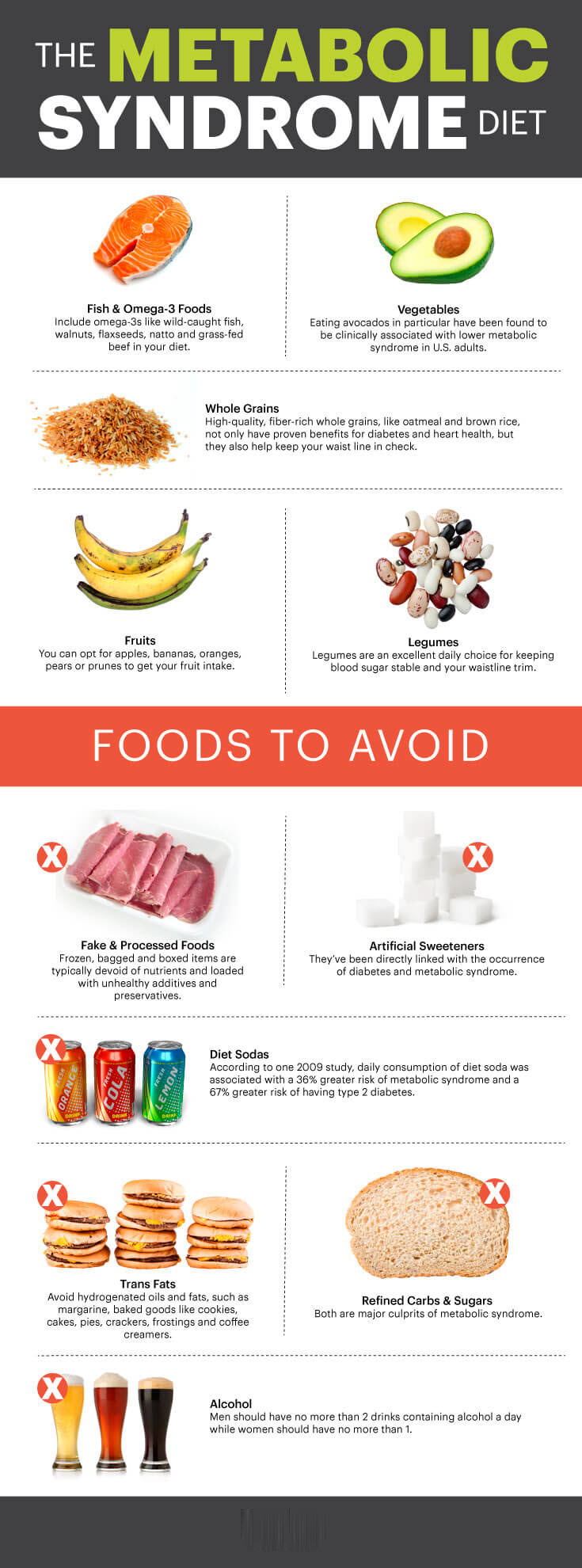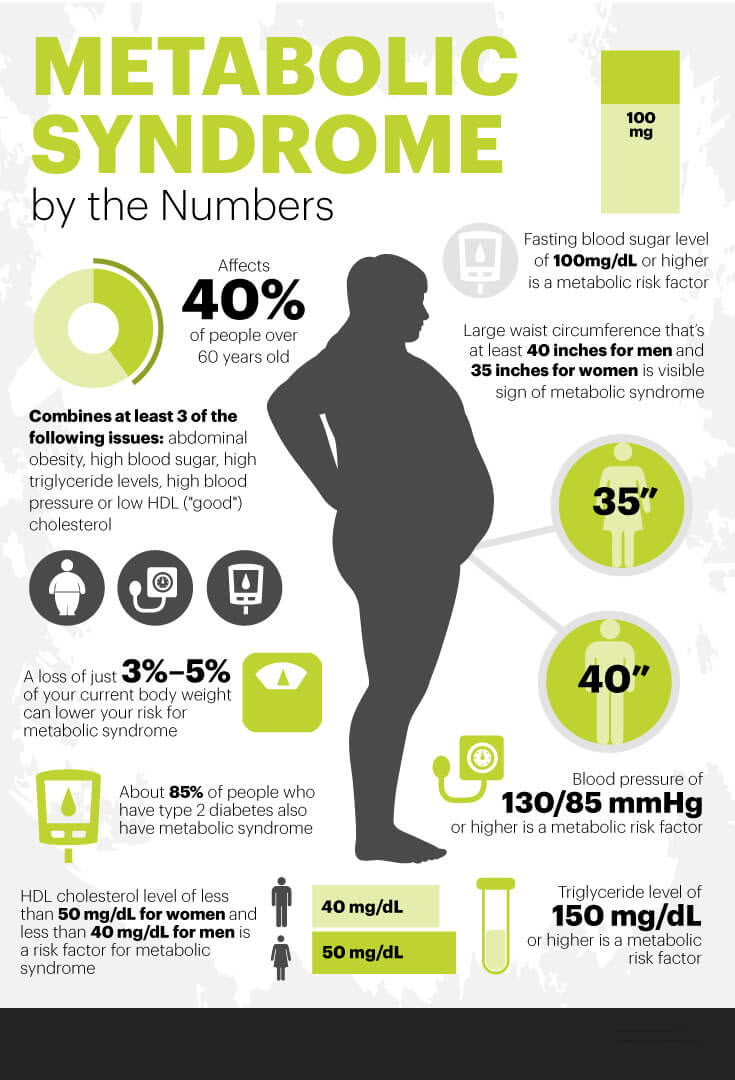Metabolic Syndrome
Metabolic Syndrome is is a health term used to describe an amalgam of various health conditions such as;
- Diabetes
- Hypertension (High Blood Pressure)
- Obesity
If you find out that you have Metabolic Syndrome, you will find yourself exposed to a much higher risk of contracting the following diseases.
Stroke, coronary heart disease, or any other illness is affecting blood vessels.
The term “metabolic” depicts the biochemical processes in connection to the body’s normal functioning. Once you have metabolic syndrome, your body is in a state of threatening malfunction.
Metabolic syndrome raises your risk for specific, concerning, and possibly life-threatening health issues mentioned at the beginning of this article.
However, not all is gloom and doom. Still, there is hope for getting your body metabolic system back on track and keeping it on track throughout your life.
A few of the best ways to circumvent metabolic syndrome include keeping a healthy weight, regularly training, and consuming a plant-centric menu while at the same time, staying away from metabolism-death foods.
A loss of just 3 % to 5 % of your body weight may lower your triglycerides, blood glucose, and the risk of developing type 2 diabetes.
More significant amounts of weight loss can help improve blood pressure readings, lower LDL (“bad”) cholesterol, and increase HDL cholesterol.
Thank God there’s a proven metabolic syndrome diet and a natural treatment plan to put your metabolic function back in regular working order.
Diet
Foods that are known to Make It Worse.
1. False and Processed Foods
Stay away from fake and processed foods as much as you can. These bagged and boxed frozen items are notoriously devoid of nutrients and filled with harmful additives and preservatives doing nothing good for your health.
A study conducted in 2015 unraveled that fast food, some of the most unhealthy processed foods in the World, inflates metabolic syndrome in children and adults.
Researchers in Brazil also discovered that increased consumption of ultra-processed foods was associated with adolescents’ metabolic syndrome.
2. Artificial Sweeteners
Artificial sweeteners such as Splenda are known to be connected with the cases of diabetes and metabolic syndrome.
Growing evidence indicates that often consumers of sugar substitutes that contain aspartame, sucralose, and saccharin can also be at an elevated risk of high weight gain and advancement of metabolic syndrome, type 2 diabetes, and even cardiovascular disease.
3. Diet Sodas
Since diet sodas contain artificial sweeteners and other unhealthy ingredients, you don’t want to touch these lethal soft drinks.
Studies reveal that diet soda consumption is associated with significantly more serious risks of select incident metabolic syndrome components and type 2 diabetes.
According to a 2009 study, one’s diet soda’s daily consumption connected with a 36 % higher risk of metabolic syndrome and a 67 % greater risk of contracting type 2 diabetes!
4. Trans Fats (Trans Fatty Acids)
Trans fats can be found in foods prepared with hydrogenated oils and fats, like margarine, baked goods like cookies, cakes, pies; crackers; frostings, and coffee creamers.
They increase LDL cholesterol and triglyceride levels, which in return is bad for your waistline, heart health, and metabolic disorders.
5. Refined Carbohydrates and Sugar
Consumption of these two is the significant culprit in high blood sugar levels, insulin resistance, and diabetes and metabolic syndrome development.
Sugar, primarily when used to sweeten beverages, is a primary culprit, as are refined carbs.
A recent study conducted in Korea, where this syndrome occurrence is high, examined the effects of refined carbohydrates connected to this specific metabolic disorder.
The researchers found that “the percentage of energy from carbohydrates in men and eating of refined grains, such as white rice, in women, was connected with metabolic syndrome.”
6. Alcohol
Limiting alcohol intake is crucial to metabolic syndrome and fair health overall. If you are using too much alcohol, it can elevate your blood pressure and also triglyceride number.
Alcohol as well adds extra calories to your diet, which in return can cause weight gain.
However, limited consumption of alcohol can be beneficial for you, as a meta-analysis released in Clinical Nutrition revealed while high alcohol consumption elevates the chance of metabolic syndrome,
“ light alcohol consumption seems to be in connection with a minimized risk of metabolic syndrome.”
Men should stay with no more than two drinks with alcohol per day, whereas women should do no more than one drink containing alcohol. One drink is:
- 12 ounces or 354 ml of beer
- 5 ounces or 147 ml of wine
- 1.5 ounces or 44 ml of liquor
Foods that can Heal
When we talk about metabolic syndrome and promoting good health overall, you should be focusing on eating whole, authentic, high-quality foods and drinks.
Here are some of the top list of foods to heal and prevent metabolic syndrome:
1. Fish & Omega-3 Foods
The omega-3 present in wild-caught, cold-water fish, has been proven to help regulate heartbeat, reduce blood pressure, decrease blood clot formation, and reduce overall inflammation, all of which fall risk of heart attacks strokes.
Omega-3 foods are also cholesterol-lowering foods that help reduce triglycerides and LDL cholesterol. Other omega-3 foods include walnuts, flaxseeds, natto, and grass-fed beef.
2. Vegetables
Dark toned leafy greens like kale and spinach, avocado, broccoli, cabbage, and carrots are just a couple of the numerous options when it comes to your daily intake of vegetables, which are loaded with disease-fighting and anti-inflammatory antioxidants and phytonutrients.
Particularly, Eating avocados is clinically connected with lower metabolic syndrome in U.S. adults since avocado benefits your stomach.
Think of a rainbow as you make your daily vegetable choices (red bell peppers to pumpkin to yellow squash to arugula to purple eggplant).
This way, not only do you keep your meals interesting, but you obtain all of the significant vitamins, and nutrients vegetables can offer you!
3. Fruits
Suppose you need something that you can consume quickly on the go, choose apples, bananas, oranges, pears, or plums. Similar to vegetables, various options taste good and help with metabolic syndrome.
Daily fruit consumption is an easy habit to develop and therapeutic, as long as you do not overdo the natural sugar (I have not done so yet).
Pomegranate seeds, in particular, help relieve metabolic syndrome. This effect could also explain how some of their derived compounds alleviate the health damage caused by metabolic syndrome.
4. Legumes
Some of the delicious and tasty legumes I have tried are lentils, chickpeas, beans, lentil soup, peas, quinoa, chia seeds, pea soup.
This is particularly useful to prevent metabolic syndrome, as it is a good source of protein, fiber, protein, and fiber-rich carbohydrates.
A 2014 research looked at the effects of legumes on metabolic syndrome, and the researchers found that Mets components were less common in people who regularly consumed legumes.
They used data from 2,027 people removed from the Isfahan Healthy Heart Program to determine their carbohydrate, protein, fiber, and fiber levels – rich carbohydrates in the blood.
5. Whole Grains
High-fiber foods, such as natural whole grains, including oatmeal as well as brown rice, have proven beneficial for diabetes and heart health, but they also aid in keeping your waistline within limits. Therefore, whole grains are a part of a balanced, healthy metabolic syndrome diet treatment plan.
Supplements
1. Ginseng, Berberine & Bitter melon
A research study published in 2009 showed that ginseng, berberine, and bitter melon, which are usually used in Chinese traditional medicine, are healthy natural remedies for metabolic syndrome.
They help control glucose and lipid metabolism, which directly and positively impact weight management.
2. Holy Basil
When research done by the Department of Home Science at Azad University of Agriculture and Technology in India scrutinized the effects of holy basil have on blood glucose and also on serum cholesterol levels in people through double-blind clinical tests,
the outcomes proved that holy basil invoked remarkable improvements in blood glucose control and light improvements in cholesterol levels.
This study shows that basil supplementing may be a good and safe way to help control diabetes and minimize complications resulting from the disease, such as metabolic syndrome.
3. Spirulina
Spirulina has phycocyanin. Pigment scientists have discovered it possesses antihypertensive traits. Hence it is lowering blood pressure).
Researchers from Japan claim that this is due to consuming the blue-green algae reverses endothelial dysfunction in metabolic syndrome.
4. Maca Root
Maca root increases the body’s glutathione levels, which improves your immune system and disease resistance and helps properly balance cholesterol levels in the body.
Besides, it significantly improves glucose tolerance by lowering glucose levels in the blood, which benefits heart health and conditions like diabetes or metabolic syndrome.
Natural Metabolic Syndrome Treatment
1. Essential Oils
Three fantastic essential oils for weight loss are grapefruit, cinnamon, and ginger.
Grapefruit essential oil works with your body in activating enzymes that help your body break down brown body fat.
Cinnamon oil has been repeatedly shown to regulate blood glucose levels and the thing inside your body known as GTF, glucose tolerance.
Thanks to that, cinnamon oil is also fantastic for anybody with diabetes.
Ginger oil curbs sugar cravings and helps reduce inflammation in the body.
If you’re going to lose weight, it’s vital that you also thwart inflammation and help digestion and absorption of nutrients, where ginger oil helps you do.
2. Burst Training
Getting rid of belly fat is critical when we talk about handling metabolic syndrome.
Burst training helps the body acts as a fat-burning engine.
It comprises exercising at 90 % to 100 % of your maximum effort for 30 to 60 seconds, slowing it down to low-impact for a recovery period of just 30 to 60 seconds, and then bumping it back up again.
If you’ve spent hours on the treadmill without results, it’s because long-distance cardiovascular exercise can decrease testosterone and raise cortisol, the stress hormone.
Increased cortisol levels stimulate the appetite, increase fat storing, and slow down or inhibit exercise recovery.
If burst training isn’t for you, aim for at least 30 minutes per day of moderate-intensity exercises, such as brisk walking.
3. Lose Weight
With diet and exercise, losing weight may reduce insulin resistance and hypertension, helping to get metabolic syndrome back under control.
4. Quit Smoking
Enjoying cigarettes can lead to serious health problems and worsen the health consequences of metabolic syndrome and multiply your likelihood for heart problems and stroke, among various other major health concerns.
Conventional Treatment
I can say that intensive and heart-healthy lifestyle changes are usually the primary treatment for metabolic syndrome since lifestyle changes are the natural approach to the disorder’s root causes.
Recommended lifestyle changes usually include a heart-healthy diet, good stress management, losing and keeping a healthy weight, more physical activity, and stop smoking.
Suppose lifestyle changes are not giving useful results. In that case, your MD will probably prescribe medications to target and control risk factors, like hypertension, high triglycerides, low HDL (“good”) cholesterol, and elevated blood sugar.
A doctor’s primary goal when treating metabolic syndrome is to reduce the risk of coronary heart disease. The second treatment goal is to prevent the onset of type 2 diabetes if it hasn’t already developed.
Symptoms & Risk Factors
It’s alarming but true that many of the disorders connected with metabolic syndrome are without any symptoms.
However, one ubiquitous visible sign of metabolic syndrome is a large waist circumference: at least 40 inches for men and 35 inches.
If most of your fat is found around your waist rather than at your hips, you’re at an increased risk for heart disease and type 2 diabetes.
Other symptoms and risk factors include:
1. High Fasting Blood Sugar
If you are diagnosed with very high blood sugar, you may feel the effects of diabetes like unusual thirst, frequent urination, fatigue, and blurred eyesight.
An average fasting blood sugar level is below 100 mg/dL.
A fasting blood sugar level within 100–125 mg/dL is known as prediabetes.
A fasting blood sugar level of 126 mg/dL or more is considered to be diabetes.
A fasting blood sugar level with 100 mg/dL or more (or being on medicine to handle high blood sugar) is considered a metabolic risk factor.
2. High Blood Pressure
High blood pressure is one more symptom and a risk factor for metabolic syndrome that can slip without noticing unless you regularly monitor blood pressure.
A BP of 130/85 mmHg or more (or being on medicine to treat high blood pressure) is considered a metabolic risk factor.
3. High Triglycerides
Another sign of metabolic syndrome is an increased triglyceride level. Triglycerides are a type of fat or lipid that can be found in your blood.
When you eat, the body converts any calories it doesn’t need to use at the moment into triglycerides.
A triglyceride of 150 mg/dL or higher (or being on medicine to treat high triglycerides) is a metabolic syndrome metabolic risk factor.
4. Low HDL Cholesterol
HDL cholesterol is usually referred to as “good” cholesterol since it helps remove cholesterol from your arteries.
An HDL cholesterol level lower than 50 mg/dL for women and lower than 40 mg/dL for men (or being on medicine to treat low HDL cholesterol) is a risk factor for metabolic syndrome.
A doctor may diagnose metabolic syndrome based on the results of a physical examination and blood tests.
Causes
The two main leading causes of metabolic syndrome are overweight or obesity and shortness of physical activity.
A 2017 research study highlighted that an hour of weekly resistance training was connected to a 29 % lower risk of developing metabolic syndrome than no resistance exercising at all.
Contributors who coupled aerobic exercise with their resistance training showcased a 25 % lower risk.
Metabolic syndrome is a metabolic disease directly connected with insulin resistance, much more found in obese and non-active people.
Let’s see what insulin resistance is.
A regular digestive system dissolves food into glucose.
Subsequently, insulin, a hormone produced by the pancreas, aids the glucose enter your cells to be treated as fuel.
But, should you experience insulin resistance, your cells will not react in a typical way to insulin, and therefore, the glucose cannot enter your cells as fast.
This phenomenon derives from high glucose levels in your blood-stream regardless of your body’s attempt to handle the glucose by producing more and more insulin.
If this goes on long enough, your body cannot make enough insulin to maintain normal blood glucose levels, and you develop diabetes.
Since about 85 percent of people with type 2 diabetes also have metabolic syndrome, if you develop diabetes, your likelihood of having metabolic syndrome increases by a substantial margin.
Another risk factors, most of which are unfortunately out of your control that increases your chances of having metabolic syndrome include:
- Age — The risk of metabolic syndrome goes up with age, affecting 40 % of people over 60 years of age.
- Race — Hispanics and Asians appear to be at higher risk of acquiring metabolic syndrome than people of other races.
- History of Diabetes in Family — more likely, you will have metabolic syndrome should you possess a family history of type two diabetes or if you contracted diabetes while pregnant (gestational diabetes).
- Other illnesses— The risk of metabolic syndrome is greater if you have ever had cardiovascular-disease, non-alcoholic fatty liver disease, or polycystic ovary syndrome.
Besides, researchers keep on studying other health conditions that may play a significant role in metabolic syndrome, including:
- Gall-stones
- Breathing issues during sleep (such as sleep apnea)
Final Thoughts
Metabolic syndrome is becoming more prevalent due to a rise in obesity rates among children and adults. It can even overtake smoking as the leading risk factor for heart disease in the not so distant future.
Hopefully, there is realistic hope for naturally preventing metabolic disorders in the body.
You can prevent or delay it, mostly with something mainly in your control — lifestyle changing.
Every day and long-lasting effort to keep a healthy living style is your best bet to stay away from metabolic syndrome and all the complications that can arise from this multi-dimensional health struggle! So keep the following in mind:
- Metabolic syndrome is an illness that involves not a single but an amalgam of three or even more of the following health conditions: abdominal obesity, high blood sugar, high triglyceride levels, high blood pressure, or low HDL (“good”) cholesterol.
- On a metabolic syndrome diet treatment plan, you should avoid fake and processed foods, artificial sweeteners, diet sodas, trans fats, refined carbohydrates and sugar, and alcohol. Foods to eat include fish and omega-3 foods, vegetables, fruits, legumes, and whole grains. The following supplements are also beneficial for metabolic health: ginseng, berberine, bitter melon, holy basil, spirulina, and maca root.
- Other natural remedies include essential oils, burst training, losing weight, and not smoking.
- About 85 % of people who are with type 2 diabetes also have this syndrome.
- This disease’s symptoms and risk factors include large waist circumference, high fasting blood sugar, high blood pressure, high triglycerides, and low HDL cholesterol.
- The two leading causes of this syndrome are overweight or obesity and a lack of physical activity.
Reference
The above article thesis is confirmed by the following well-trusted academic or government sources:
- ncbi.nlm.nih.gov
- csauk.ac.in











